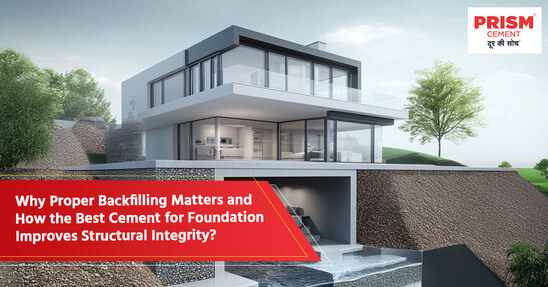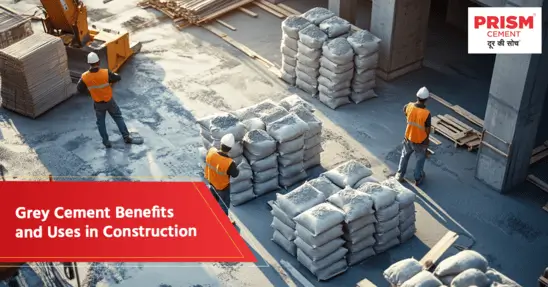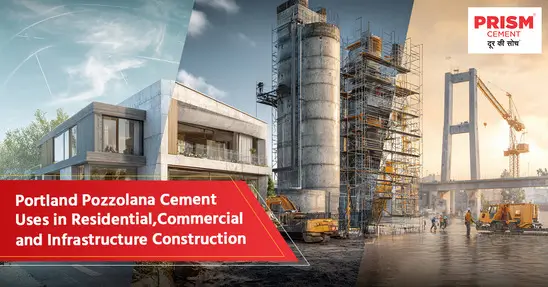A robust construction foundation is critical for the stability and longevity of any structure. Choosing the best cement for foundation is essential and proper backfilling plays an equally vital role in ensuring the strength and durability of the structure. Backfilling not only supports the cement foundation but also helps in distributing loads evenly, reducing the risk of cracks and settlements.
In this blog, we’ll dive into the techniques, variables and materials involved in backfilling, as well as its importance in construction.
What are the Key Techniques for Backfilling Foundations?
Backfilling is an intricate process that requires precision and the right approach. Key techniques for backfilling include:
- Layered Filling: Material is backfilled in layers, compacting each layer thoroughly to achieve optimal density and reduce voids.
- Compaction: Proper compaction is crucial for preventing settlement issues. Vibratory rollers or plate compactors are commonly used for this purpose.
- Moisture Control: Ensuring the right moisture content in the backfill material enhances compaction and prevents waterlogging.
Using the best cement for construction during foundation work ensures structural integrity, while proper backfilling techniques maintain stability.
How is Backfilling Defined in Construction?
In construction, backfilling refers to the process of refilling excavated areas around a footing foundation or other structural components. It involves placing soil, sand or crushed materials to fill gaps and create a stable base for construction. Proper backfilling reduces pressure on walls, prevents water seepage, and ensures that the cement foundation remains strong over time.
Variables That Impact the Backfilling Process in Foundations
Several factors influence the effectiveness of backfilling:
- Soil Type: The type of soil determines compaction and load-bearing capacity
- Foundation Type: Different foundation types, such as isolated footings, combined footings and raft foundations, may require varying backfill methods
- Material Selection: Choosing suitable materials like sand, gravel or recycled aggregates impact the strength and stability of the backfill
- Moisture Levels: Excessive moisture can weaken backfilled materials, leading to settlement. Proper drainage systems mitigate this risk.
Selecting the best cement for foundation combined with high-quality backfill materials ensures a strong and durable base.
Types of Backfilling in Foundation
Backfilling materials vary based on the specific needs of the structure and the types of cement used. Below are some commonly used materials for backfilling:
Sand Backfill
Sand is a popular choice due to its excellent drainage properties and ease of compaction. It prevents waterlogging and provides a solid base for a cement footing.
Crushed Stone Backfill
Crushed stone offers superior load-bearing capacity and is often used in areas with heavy structures. It pairs well with Portland cement, ensuring enhanced durability.
Combined Footing
For structures with multiple footings, backfilling involves using gravel or sand mixtures. This method supports load distribution across different foundation types.
Recycled Materials Backfill
Eco-friendly options like recycled concrete or crushed bricks are cost-effective and sustainable. When paired with the best cement for construction, these materials ensure strength and durability.
Advantages of Backfilling Foundations
Proper backfilling provides several advantages to ensure a strong and stable construction:
- Improved Structural Stability: It enhances the load-bearing capacity of the foundation and prevents settlements.
- Enhanced Drainage: Well-compacted materials prevent water accumulation and protect the cement foundation from damage.
- Prevention of Cracks and Seepage: Proper backfilling minimizes lateral pressure on walls, reducing the risk of cracks.
- Cost Savings: Preventing structural issues through proper backfilling saves costs associated with repairs and maintenance.
Incorporating the right materials and the best cement for foundation ensures a long-lasting structure.
Conclusion
Backfilling is a cornerstone of strong construction foundations, ensuring stability, durability and resistance against environmental factors. From selecting the right materials to using proper techniques, every aspect of backfilling contributes to the longevity of the structure. Coupled with high-quality Portland cement or other types of cement, proper backfilling ensures that the foundation can withstand the test of time.
If you're planning construction and looking for the best cement for foundation, consider Prism Champion All Weather Cement for its superior performance, water resistance and strength. It’s designed to complement proper backfilling practices, ensuring your construction stands strong in all seasons.
FAQs
Q1. What is backfilling in construction?
Answer: Backfilling in construction refers to refilling excavated spaces around foundations or structures using materials like sand, gravel or recycled aggregates to provide stability and support.
Q2. Why is proper backfilling important for construction foundations?
Answer: Proper backfilling ensures stability, prevents settlement, reduces lateral pressure on walls, and protects the cement foundation from moisture and seepage.
Q3. What materials are commonly used for backfilling?
Answer: Common backfilling materials include sand, crushed stone, recycled aggregates and soil, depending on the different foundation types and structural requirements.
Q4. What are the key steps in the backfilling process?
Answer: The process involves selecting suitable materials, filling in layers, compacting each layer, and ensuring proper drainage to maintain stability.
Q5. What are the risks of improper backfilling?
Answer: Improper backfilling can lead to uneven settling, cracks in the foundation, water seepage, and compromised structural integrity.


.webp)

